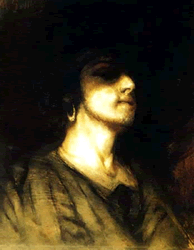| Maurycy Gottlieb [Polish Painter, 1856-1879] https://mail.google.com/mail/?dest=http%3A%2F%2Fgmail.google.com%2Fgmail Self-Portrait written as Maurycego Gottlieba MAURYCY (i.e, Moses, or Moshe) GOTTLIEB (1856-1879): The majority of the artwork in existence by Maurycy Gottlieb is in an unfinished state. For nearly a century the body of work he produced in his short life was thought to be small. Following the collapse of the Soviet Union, lists of Gottlieb artwork began to appear from Eastern Europe, mostly from holdings in Poland, with now a total of some 300 known works world-wide. One of eleven children to Isaac & Fanya Tigerman Gottlieb, Maurycy was enrolled at the Vienna Art Academy at fifteen. He later followed this with study under Polish painter Jan Matejko in Krakow. Within a half-year he had quit Matejko's studio angrily after repeatedly experiencing anti-semitism from the other art students. Gottlieb returned to Vienna and began a search for his Jewish roots; something vague for him as his parents had attempted to raise him in the then current secular school of "european enlightenment."At the age of twenty he was awarded a gold medal at a Munich art competition for the painting Shylock and Jessica, taken from Shakespeare's play Merchant of Venice. The face for Jessica was modeled on Laura Rosenfeld, the unmarried daughter of a prosperous merchant family of Vienna. Gottlieb had proposed marriage to the girl, and was initially accepted, but was rejected shortly after. It is believed that this rejection played the primary role in Gottlieb's death in 1879. Though he shortly was to arrange a marriage with Lvov native Lola Rosengarten, upon hearing of Laura Rosenfeld's marriage to a banker of Berlin, he apparently committed a form of suicide by exposure to the elements, succumbing to complications of a cold & sore throat.As a Polish-Jewish artist, Gottlieb is unique. As a Polish painter, he is considered to be the best of his generation. Though reared as a secular Jew he steadily looked back toward a heritage he had been raised to be emancipated from. His painting Day of Atonement depicts himself as child, youth and old man on the holiday of Yom Kippurim. His painting of Jesus, (Jesus preaching at Capernuam) an unusual subject for a Jewish artist before the 20th Century, depicts Jesus with prayer shawl & earlocks, speaking in synagogue. Gottlieb's many self-portraits usually show a contemporary 19th century urbanite, with an aloof, querying look.-Erik Weems |
